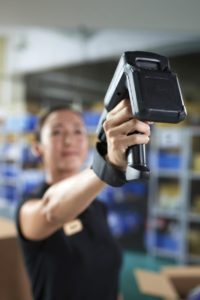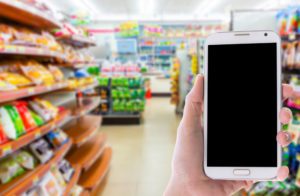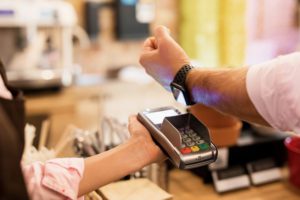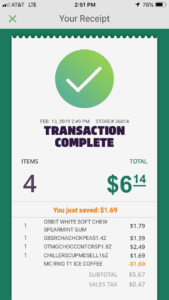Digital transformation and technology investments are changing the way many industries do business, and convenience stores are no different. As the industry experiences shifts and competition increases, technology plays a greater role in helping convenience stores achieve success. In fact, according to Convenience Store News, two thirds of c-store IT executives surveyed said that their technology budget increased in the past year.
In this article, we take a look at some of the top business priorities for convenience stores in 2020, along with the technology investments they’re making to achieve those goals.
 Read how c-stores are boosting profit margins with food sales.
Read how c-stores are boosting profit margins with food sales.
1. Better Management of Inventory and Revenue
The recent 2019 Convenience Store News Technology Study found that the top concern for c-store owners this year is inventory management at the store level. One of the primary ways they’re achieving this is by investing in automation.
In fact, 93.5% of c-stores are investing in automation, with 68.87% of the dollars being spent on store-level  technology versus 31.2% on technology for their headquarters.
technology versus 31.2% on technology for their headquarters.
Automation takes on many forms, including automated data collection, RFID, inventory, transaction tracking, and analytics. Through a combination of the latest in mobile computing, barcode scanning technologies, and software solutions, automation can help stories identify, track, and analyze inventory.
By automating inventory processes and bringing the data together at the tap of a mobile computer or tablet screen, stores can easily manage inventory, keep the right products in stock, and get a complete picture of customer purchasing activity, trends, and opportunities.
2. Improved Customer Loyalty Programs and Promotions
Inventory automation ties closely to another important initiative in the industry, which is automating loyalty programs. In fact, 54% of c-stores have already implemented automated loyalty programs, and another 25% are planning to do so in the near future.
With enhanced tracking and data collection, c-stores can track purchases and trends by individual customers, which yields insights for better inventory planning and product placements as well as personalized email marketing campaigns and discount offers.
According to Retail Dive, a Zynstra report found that nearly 40% of c-store owners stated that upgrading customer loyalty programs was a key IT priority. This is because loyalty programs are a big factor driving revenue. They also provide critical data on customers that helps store owners make better promotional and marketing decisions. Rewarding customer loyalty is necessary to get ahead, and automated loyalty programs are an effective way to do that, while freeing up time for you to focus on other important areas of business.
3. Replacing Aging Point-of-Sale Systems
Many c-stores are making technology investments to replace their aging point-of-sale (POS) systems to provide  faster checkouts, ensure EMV compliance, and accept more payment types. In fact, in 2018, 47.7% of stores said they planned to replace their POS systems this year.
faster checkouts, ensure EMV compliance, and accept more payment types. In fact, in 2018, 47.7% of stores said they planned to replace their POS systems this year.
Investing in new POS systems means they can serve customers better with mobile or self-service checkouts, faster and more secure transactions, acceptance of mobile payments such as Apple Pay and Samsung Pay, and intelligent inventory and store operation analytics.
Mobile point of sale (mPOS) solutions take it one step further—giving convenience stores the mobility and flexibility they need to serve their customers from anywhere in the store.
Older legacy POS systems weren’t designed with future needs in mind, and only address the challenges that the industry faced when the systems were first introduced. Upgrading to a flexible POS that scales with you will allow you to address current and future needs, while also adding critical functionality to help you keep up with evolving customer demands.
4. Speeding up Customer Checkouts
No one likes waiting in line to make a purchase; in fact, it’s the quickest way to lose a sale, which is why 42% of  convenience stores want to speed up their checkout processes.
convenience stores want to speed up their checkout processes.
Upgrading POS systems is one way to speed up checkouts by enabling quicker transaction processing and acceptance of mobile quick-pay methods. For example, 7-Eleven, QuickTrip, and ExtraMile have all done this by enabling acceptance of tap-to-pay payments via Apple Pay
Self-service checkouts are also becoming increasingly popular, with many stores investing in self-checkout kiosks equipped with built-in barcode scanners and payment solutions. And customers want self-checkout kiosks. According to the 2019 Convenience Store News Realities of the Aisle Study, c-store shoppers say they would be most likely to utilize self-checkout at a kiosk more than other conveniences. In fact, 13% of customers say they’ve used self-checkout in a c-store, but over 52% say they would be willing to do so if more c-stores offered it. Some stores, such as 7-Eleven, are testing out cashierless concepts—setting the stage for the future of c-stores.
Others are making technology investments in mobile checkout kiosks that they roll out during busy times. For example, Wawa, a chain of over 800 c-stores in the eastern United States, is conducting pilot tests of checkout kiosks on wheels with a barcode scanner, credit card reader, small counter, and a bagging system—all in a space no larger than a mailbox.
C-stores are trying a variety of new technology solutions in their attempts to transform the checkout process and find new ways to shave off seconds per transaction. For c-stores, where the goal is convenience over anything else, every second counts.
Making Transformations with Technology Investments
Mainstreet Inc. is proud to partner with Zebra Technologies to deliver the latest point-of-sale, inventory, barcoding, RFID, mobile computing, and data capture technologies for the retail industry. Our experts will help you provide faster service, improve your inventory management, and maximize customer loyalty and company profits.
Ready to learn more about what we do and how we can help your business manage its technology? Contact us today to request a free expert consultation.